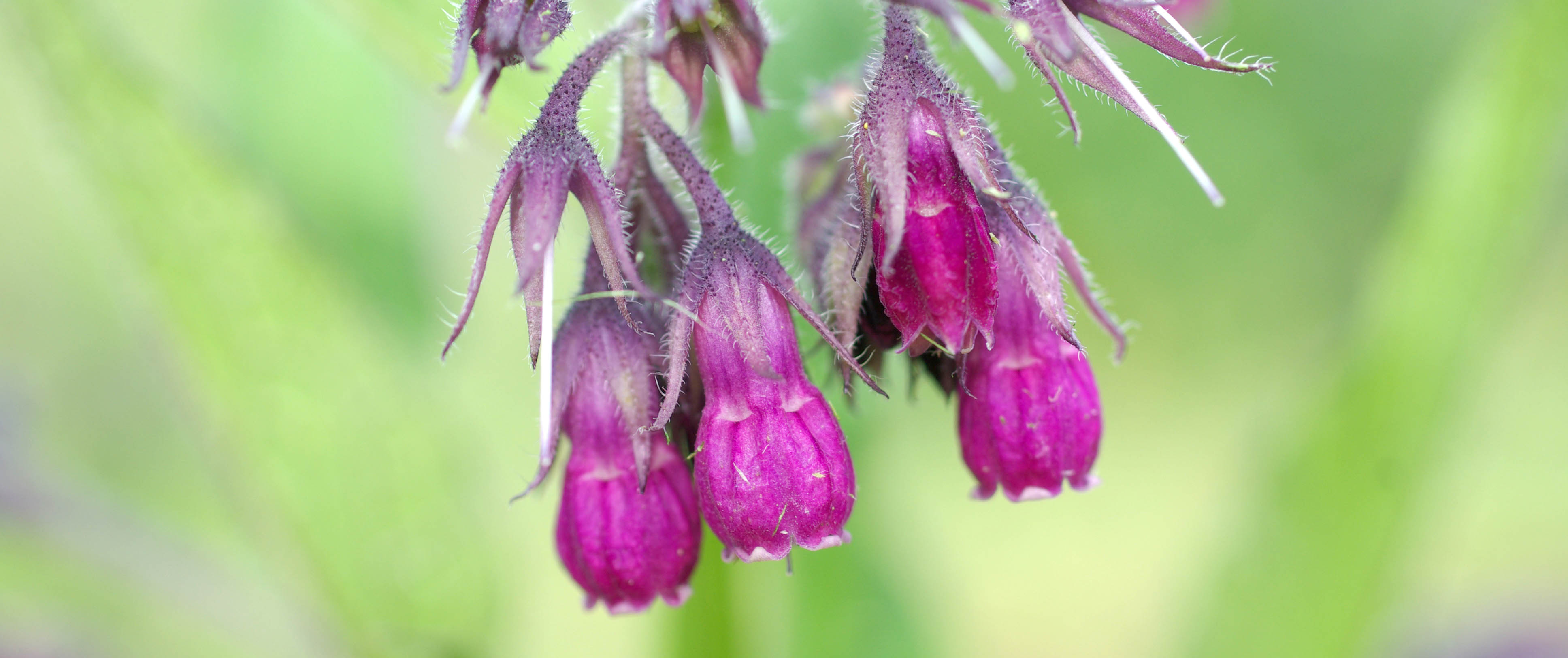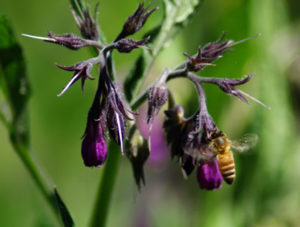
The flowers of True Comfrey (Symphytum officinale) are generally very richly arrayed and colored dark purple. The leaves are lance-shaped and not so broad as those of Russian Comfrey.
 True Comfrey is really the nicest of the Comfrey clan in my opinion. From the luscious leaves to the thick, mucilage-laden roots I find nothing to compare. For years I thought Comfrey did not make seed, because I was not aware of the true plant, which is seed-productive, although the seeds are not so easy to collect. The seeds ripen and drop on an ongoing basis. They are large, shiny and black, wedge-shaped yet rounded, smooth and sensual to the touch.
True Comfrey is really the nicest of the Comfrey clan in my opinion. From the luscious leaves to the thick, mucilage-laden roots I find nothing to compare. For years I thought Comfrey did not make seed, because I was not aware of the true plant, which is seed-productive, although the seeds are not so easy to collect. The seeds ripen and drop on an ongoing basis. They are large, shiny and black, wedge-shaped yet rounded, smooth and sensual to the touch.
They are best planted in very early spring in outdoor conditions, or given a good 30 days moist refrigeration before planting in the greenhouse or receptive garden bed. Seedlings grow fast and in time send down a good taproot. You really have to grow them for 2 years before adequate root yield can be obtained. In the mean time, the leaves can be harvested, preferably just prior to flowering. In Zones 4 to 8, it would seem reasonable to expect a summer harvest of leaf in the first year, and at least 2 harvests of aerial parts per summer in successive years.
I use fresh comfrey leaf for feed, veterinary, and compost purposes; dried comfrey leaf in salve; the fresh root as a poultice. I could not long live without Comfrey.


Ok, just to not diverge completely off-topic, thank you for my latest, wonderful seed order; one of the varieties planted was of course, comfrey. The bees and I are very much looking forward to those gorgeous purple blooms.
The picture that caught my eye, however, was the photo of the hawthorn branch, at the top of the page, in all it’s rosy, floriferous glory… Wow! Richo, do you grow this beauty, and if so, do you offer it, or it’s seed, by chance? That cultivar is breathtaking!
I tend to drink a bit of purchased hawthorn leaf and flower tea, anyway, I think this tree would be a lovely specimen tree, if I could find it. I’m a patient person, I don’t mind it waiting on it’s long germination time.
Thank you as ever,
Sabine
Hi Sabine, yes, this is our English Hawthorne (Crataegus laevigata/oxyacantha) seed available online at Strictly Medicinal Seeds. Richo
Hello!
I read an article by Monica Wilde about toxicity myths and research into the versions of comfrey. Her true common comfrey has cream colored blossoms and round leaves., and she says that there are darker pink purple types. I’m having a dickens of a time finding them! What measurements have you used to indicate that your variety is not hybridized and are true? Many thanks!
Hi Pamela, It sounds like Monica has a good understanding. True comfrey (Symphytum officinale) does have several forms, and one of them is cream colored. Another is purple colored. So she’s describing what is well known. Since our purple-flowered true comfrey (var. patens) breeds true from seed, it is not a hybrid. Hybrids do not breed true from seed. Pink-flowered comfreys are usually russian hybrids (S. officinale x S. asperimum) and are sterile. Richo
Greetings! I am curious about how you handle your Comfrey plants, i.e. do you wear gloves? I have read that the chemical that they produce is harmful if ingested/absorbed through skin. Thanks so much!
Hello Annie, Thanks for your healthy curiosity. We don’t use gloves when handling comfrey and often apply large amounts of it to our skin without harm and actually doing a lot of good. It is not a good idea to eat a lot of comfrey or make strong tea and drink it every day. It is, after all, a first aid plant, so it is not normally used like a daily tonic.
Richo
Any tips for growing in scorching memphis humid climate? I just ordered seeds and I have both full sun and part shade beds. A lot of herbs labeled full sun burn up in my climate. All my culinary herbs thrive with just morning sun here. Thanks ? ?
Tina, Comfrey does fine in Memphis. I have gardened it there myself. I think it does make sense to choose a partly shady spot. Richo
I got some true comfrey from you years ago. It has reseeded everywhere and was a bit of a pest until I learned about fermenting it for a holistic spray for my cider apple trees (along with nettle and horsetail ferments) wow, our trees rejoice and the comfrey does not seem bothered by being frequently cut to the ground.
Right, good point, when we think of an herb as invasive it just means we haven’t discovered its utility! r
Is this type good for plant fertiliser, i.e. comfrey tea or should I go for the Bock 14 variety for that?
To split hairs, True Comfrey is probably a little better to use in human medicine, and Russian Comfrey is probably a little better to use as animal feed and in compost making.
What do you mean by “moist refrigeration”? I have not heard this term. Do you mean planted in potting medium and kept moist in the refrigerator or a cold area?
Moist refrigeration means putting the seeds in moist medium (such as hydrated coir or peat, even sand) in a plastic bag in the fridge, not the freezer. This is similar to the kind of cold dormancy experienced outdoors in nature. Generally a specific timeperiod is given, as different species require different dormancy periods. 30 days of cold, moist refrigeration serves to improve germination of seeds that are mildly dependent on cold stratification.
Thank you! That helps.
One year ago we moved to a small neighborhood outside of Littlefield, Arizona. The temperatures in summer can reach 120 degrees F and they are often accompanied by winds in the double digits. What herbs or methods for keeping the plants alive would you recommend? I am currently building raised beds and “shelters” so I can keep something alive..:(
Any input would be greatly appreciated. I miss my comfrey!
Hello MK, Thanks for getting in touch. If you go to the desert and you look for areas of greatest plant diversity, you’ll find them in the arroyos where there is shade thrown by rock walls and seasonal availability of water. Your desert garden is the same–if you want to grow diversity, provide shade and water. If you want to grow xerophytic cacti, don’t bother with the shade and water. Comfrey is going to need the shade and water. Use 40% shadecloth stretched well above your beds, so you can stand underneath without having the shadecloth brush your head. There is something uncomfortable about that, and you want the garden to be comfortable. Set up drip-style misters to go off morning and evening. This saves water and keeps all kinds of plants alive. I suggest our true comfrey plants, to give you a robust start. There is much more on all this in my book “The Medicinal Herb Grower.” Cheers, richo
I live in AZ close to the border, about 1.5 hours SE of Tucson. I find my comfrey does well with part shade and frequent watering. It survives drought once established but doesn’t grow much, the leaves shrivel but when the monsoons come they thrive. The best growing ones I have do seem to enjoy mulch!
I bought some of your seeds and was wondering when I can plant the True Comfrey seeds into to soil outdoors. I live in Prescott, AZ. The last frost date predicted is April 30th but I don’t know if that is current information. Our temperatures right now still get down into the low 20’s and our highs are probably in the 60’s. This changes weekly, of course, because we’ve barely had a winter and the weather is crazy. But, I don’t want to wait too long to get them in the ground but fear them getting too cold if I plant now. Suggestions? Thank you.
Hi Tracy, I don’t personally direct-seed these because I like the control afforded by greenhouse culture, but you can direct-seed them right now, mark your spot well, they need that cold before germination is efficient, go ahead and plant them. Richo
I grow beautiful Comfrey in my beds here in Spring Branch Texas.. love this plant!
I live in South Texas. I have some Comfrey seed that I purchased awhile back. When is the best time to plant these? Would you suggest direct sow or start in containers and then plant when the small plants come up?
These can be planted anytime in Texas. Give the seed a couple of weeks of moist refrigeration in medium before planting in a warm place. It always makes sense to plant perennials in pots and then transplant out–it is more saving of the seed and gives better control and better overall results. If you don’t have a reasonable place for growing plants in pots (sunroom, greenhouse) then direct seeding in a clean seedbed is also a workable choice.
Will I ever be successful growing comfrey here in Phoenix Arizona? I here it’s also great for bringing nutrients from deep in the soil. And winters here are warm most of the time
Hi Lori, In order to grow good comfrey in hot climes you have to think about the aerial parts and the root system both. If you give about 40% shade to the leaves and plant into rich, well-drained soil, mulch around the plant with straw and water frequently, you can get monumental individuals. Comfrey is good for almost everything. richo
I am in southern California, San Gabriel city which is near Pasadena. Can I grow comfrey now in the garden from seeds?
The true comfrey is best sown in cold soils, so it would be better to buy comfrey plants during the summer.
Comfrey has been a favorite and there are various examples around our garden. The flowers are purple and a beautiful addition to the herbal bouque! I didn’t know growing from seed is an option and will go to my supplier for some.